
Squirtle, known as Zenigame in Japan, is a Pokémon species in Nintendo and Game Freak's Pokémon franchise. It was designed by Atsuko Nishida. Its name was changed from Zenigame to Squirtle during the English localization of the series in order to give it a "clever and descriptive name." In animated appearances, Squirtle is voiced in Japanese by Rikako Aikawa and in English localizations by Eric Stuart, and later Michele Knotz.

Pikachu is a Pokémon species in Nintendo and Game Freak's Pokémon media franchise, and the franchise's mascot. First introduced in the video games Pokémon Red and Blue, it was created by Atsuko Nishida at the request of lead designer Ken Sugimori, with the design finalized by Sugimori. Since Pikachu's debut, it has appeared in multiple games including Pokémon Go and the Pokémon Trading Card Game, as well as various merchandise. While Pikachu has been primarily voiced in media by Ikue Ōtani, other actors have also voiced the character including Kate Bristol, Ryan Reynolds, Kaiji Tang, Hidetoshi Nishijima, Tōru Ōkawa, and Koichi Yamadera.
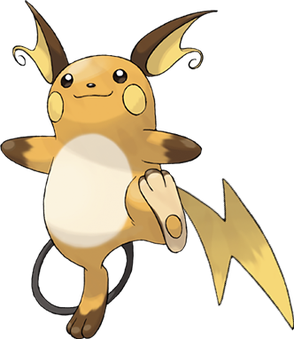
Raichu is a Pokémon species in Nintendo and Game Freak's Pokémon media franchise, and the evolved form of series mascot Pikachu. First introduced in the video games Pokémon Red and Blue, it was created by Atsuko Nishida at the request of lead designer Ken Sugimori, with the design finalized by Sugimori. Since Raichu's debut, it has appeared in multiple games including Pokémon Go and the Pokémon Trading Card Game, as well as various merchandise. In media related to the franchise, Raichu has been voiced by various voice actors, including Kei Shindō, Fumiko Takekuma, and Casey Mongillo.

Jigglypuff, known in Japan as Purin, is a Pokémon species. Jigglypuff first appeared in the video games Pokémon Red and Blue and subsequent sequels, later appearing in various merchandise, spinoff titles and animated and printed adaptations of the franchise. Jigglypuff is voiced by Rachael Lillis in English and by Mika Kanai in Japanese. In the live-action musical Pokémon Live!, Jigglypuff is portrayed by Leah Smith. Jigglypuff is also known for singing a lullaby in the Pokémon anime series.

Eevee is a Pokémon species in the Pokémon franchise. Created by Satoshi Tajiri and designed by Motofumi Fujiwara, it first appeared in the video games Pokémon Red and Blue. It has later appeared in various merchandise, spinoff titles, as well as animated and printed adaptations of the franchise. It is also the game mascot and starter Pokémon for Pokémon: Let's Go, Eevee!
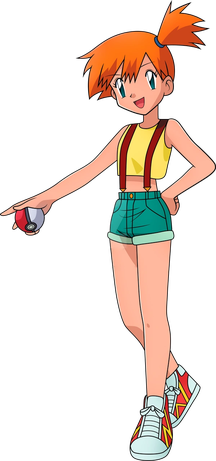
Misty, known as Kasumi in Japan, is a fictional character in the Pokémon franchise owned by Nintendo and created by Satoshi Tajiri. She has appeared as a Gym Leader in the Pokémon video games Pokémon Red and Blue, Pokémon Gold and Silver, and their respective remakes. She was a protagonist in the ongoing anime for the first five seasons, travelling alongside Ash Ketchum and Brock / Tracey to become the world's best Water-type Pokémon trainer before departing home to Cerulean City to run the family gym, but made recurring appearances after and eventually resuming her journey after Ash won the rank of World Champion. The character has also appeared in manga like Pokémon Adventures. She specialises in Water Type Pokémon. Her Japanese voice actress is Mayumi Iizuka, while her English voice was supplied by Rachael Lillis and Michele Knotz.
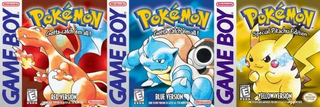
Pokémon Red Version and Pokémon Blue Version are 1996 role-playing video games (RPGs) developed by Game Freak and published by Nintendo for the Game Boy. They are the first installments of the Pokémon video game series, and were first released in Japan as Pocket Monsters Red and Pocket Monsters Green, followed by the special edition Pocket Monsters Blue later that year. The games were released internationally in 1998 and 1999 as Pokémon Red and Pokémon Blue, while an enhanced version named Pokémon Yellow Version: Special Pikachu Edition, was released in Japan in 1998 and in other regions in 1999 and 2000.

Mew is one of the many fictional species in the Pokémon franchise. It is a small, pink, Psychic-type Mythical Pokémon, which are incredibly rare and powerful Pokémon typically available only via special events. It was added to Pokémon Red and Blue by Game Freak programmer Shigeki Morimoto at the tail end of the games' development. Though it was not planned to be obtainable, after it was discovered through data mining, its presence in the games was surrounded by many rumors and myths. For years, Mew could not be obtained legitimately in the games except through some specific Pokémon distribution events, though it could be obtained through a variety of glitches.

Psyduck, known as Koduck in Japan, is a Pokémon species in Nintendo and Game Freak's Pokémon franchise. Created by Ken Sugimori, Psyduck first appeared in the video games Pokémon Red and Blue and later in sequels. It has later appeared in various merchandise, spinoff titles and animated and printed adaptations of the franchise. A Psyduck also appears as part of the main cast in the live-action animated film Pokémon Detective Pikachu. Psyduck has been voiced by Michael Haigney and Rikako Aikawa since its debut.
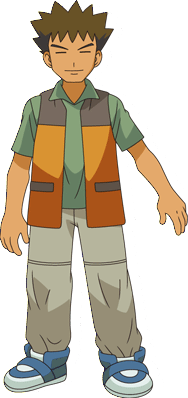
Brock, known as Takeshi (タケシ) in Japan, is a fictional character in the Pokémon franchise owned by Nintendo. In the Pokémon video games, he is the Gym Leader of Pewter City in the Kanto region and mainly uses Rock-type Pokémon. In the anime series, Ash first battles him and then invites Brock to accompany him on his journey so that Brock can become a Pokémon breeder. He exited the series at some point, replaced by Tracey Sketchit, due to worries that people may find him to be a racial stereotype due to his thin eyes. However, when the company noticed that no one complained, they reintroduced him. He has generally been well-received, with fans of the anime happy whenever he is brought back into the series.
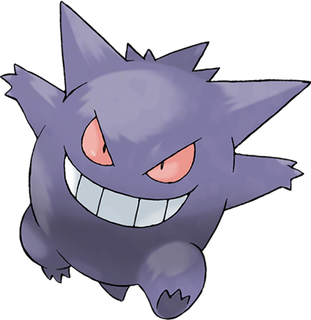
Gengar is a Pokémon species in Nintendo and Game Freak's Pokémon media franchise. First introduced in the video games Pokémon Red and Blue, it was created by Ken Sugimori, and has appeared in multiple games including Pokémon GO and the Pokémon Trading Card Game, as well as various merchandise related to the franchise. In Japanese, Gengar has been voiced by multiple actors which include Kiyonobu Suzuki, Kōichi Sakaguchi, Nobutoshi Canna and Yasuhiro Mamiya. Meanwhile, in English, the species was voiced by Ted Lewis and Marc Thompson.

"Pokémon, I Choose You!" is the first episode of the Pokémon anime series. It was first broadcast on April 1, 1997 on TV Tokyo. The episode was directed by Masamitsu Hidaka and written by Takeshi Shudo.

Charizard, known as Lizardon in Japan, is a Pokémon in Nintendo and Game Freak's Pokémon franchise. Created by Atsuko Nishida, Charizard first appeared in the video games Pokémon Red and Blue and subsequent sequels. They have later appeared in various merchandise, spinoff titles and animated and printed adaptations of the franchise. Shin-ichiro Miki voices Charizard in both the Japanese and English-language versions of the anime. An orange, dragon-like Pokémon, Charizard is the evolved form of Charmeleon and the final evolution of Charmander. It also has two "Mega Evolved" forms, Mega Charizard X and Y, that were likely both designed by Tomohiro Kitakaze, the designer of Mega Charizard X. It also has a Gigantamax form in Pokémon Sword and Shield, which changes its appearance and size.

Jynx, known in Japan as Rougela, is a Pokémon species in Nintendo and Game Freak's Pokémon franchise. Jynx first appeared in the video games Pokémon Red and Blue and sequels, later appearing in various merchandise, spinoff titles, or animated and printed adaptations of the franchise. While no English voice actors have been attributed for the character, in Japan they have been voiced by Mayumi Tanaka, Chie Satō, Kujira and Chiyako Shibahara
Atsuko Nishida is a Japanese graphic artist who previously worked at Game Freak and TOYBOX Inc. She designed a number of creatures for the Pokémon franchise, including one of the most well-known Pokémon species, the franchise's mascot Pikachu.

Ditto, known in Japan as Metamon, is a Pokémon species in Nintendo and Game Freak's Pokémon media franchise. First introduced in the video games Pokémon Red and Blue, it was created by the design team as a tribute to the pop culture yellow smiley face ideogram, and its design finalized by Ken Sugimori. Since its initial appearance it has appeared in multiple games including Pokémon GO and the Pokémon Trading Card Game, as well as various merchandise related to the franchise. In addition, it appears in manga and anime adaptations of the Pokémon franchise, with its appearances in the latter being voiced by Kotono Mitsuishi in Japanese, and both Rachael Lillis and Michele Knotz in English. A Ditto also appears in the 2019 film Detective Pikachu masquerading as a human woman named "Ms. Norman" and portrayed by Suki Waterhouse.
















